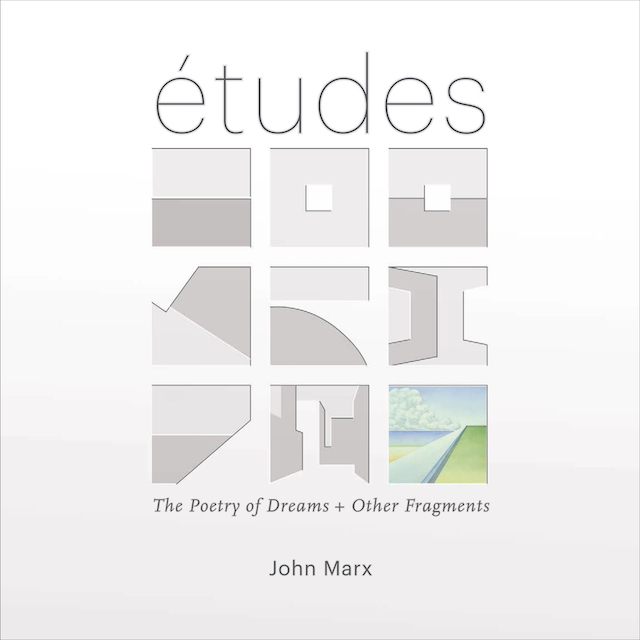Études
Études: The Poetry of Dreams + Other FragmentsJohn MarxORO Editions, March 2020Hardcover | 11-1/2 x 11-1/2 inches | 160 pages | English | ISBN: 978-1943532421 | $65.00PUBLISHER'S DESCRIPTION: John Marx’s watercolors, first published in the Architectural Review, are a captivating example of an architect’s way of thinking. Subtle and quiet they are nonetheless compelling works in how they tackle a sense of place, of inhabiting space and time all the while resonating with the core of one’s inner being. There is an existential quality to these watercolors that is rare to be found in this medium that is something akin to the psychologically piercing observational quality of artists like De Chirico or Hopper. As architects strive to communicate their ideas, it is interesting to explore the world of Marx’s watercolors as an example of a humane approach to conveying emotional meaning in relation to our environment. Marx’s subject matter read like “built landscapes” heightening the role of the human-made yet wholly in balance with the natural world. This is a message and sentiment that is perhaps more important than ever to relay to audiences. John Marx, AIA, is the founding design principal of Form4 Architecture in San Francisco, CA. He advocates for the inclusion of Philosophy, Art, and Poetry in the thoughtful making of place. REFERRAL LINKS: dDAB COMMENTARY: When I think of architectural watercolors, travel sketches come to mind. Many architects from decades and centuries ago documented their "grand tours" of Italy and other parts of Europe through watercolors. When I spent a semester in Italy 25 years ago, watercolor was one of the preferred methods of capturing the color, light, and forms of hill towns, churches, and other iconic Italian places. No matter how hard I tried, I never got the hang of watercolors; pencils were my preferred media. Nevertheless, I can still appreciate good architectural watercolors, especially when they depart from the grand-tour norm. If the watercolors of John Marx, "chief artistic officer" of San Francisco's Form4 Architecture, are documents of his travels, he has been venturing through natural and urban landscapes that are a mix of the real and the imaginary. The urban vistas, such as those shown in the spreads below, look both familiar and unfamiliar at the same time. They look like American cities, but not necessarily particular ones, much less specific places in named cities. Marx reveals as much in his short essay — one of four in the book, which includes those by Laura Iloniemi, Owen Hopkins, and Pierluigi Serraino — when he calls the watercolors "part real, part dream, part form approaching abstraction." For me this abstraction is the most appealing aspect of Marx's watercolors — or Études. On the one hand, the character of the places, be they real or imagined, recalls those depicted by artists Giorgio de Chirico and Edward Hopper; in regards to the former, Marx often inserts cubes and other objects into scenes to create quasi-surreal juxtapositions, while the urban vignettes almost transport us to the pre-glass-box-skyscraper era of Hopper. On the other hand, Marx tends to paint predominantly solid areas in his watercolors rather than traditional gradient washes; this atypical application of watercolor gives his Études a certain flatness that resonates with me. Most of Marx's watercolors are nine or ten inches square, so it makes sense that the book collecting dozens of them painted over numerous decades is large in size. Readers are seeing most of the watercolors at the same size as their originals. Aiding the presentation is the rough, heavyweight paper they are printed on, an approximation of the paper watercolor artists use. Paired with the many Études are small ink sketches that were the gestation for the watercolors, as well as poems by Marx. The latter are laid out by Kirk Johnson and Jeremy Mende in a way that binds words and images, sometimes clearly, as when the words cascade down the page akin to the buildings on the opposite page. But often the relationship is more tenuous, as if the poems are their own formal explorations and they work with the watercolors to invite readers to slow down and decipher what they mean — if anything. SPREADS:

John Marx
ORO Editions, March 2020
Hardcover | 11-1/2 x 11-1/2 inches | 160 pages | English | ISBN: 978-1943532421 | $65.00
PUBLISHER'S DESCRIPTION:
REFERRAL LINKS:
SPREADS:











